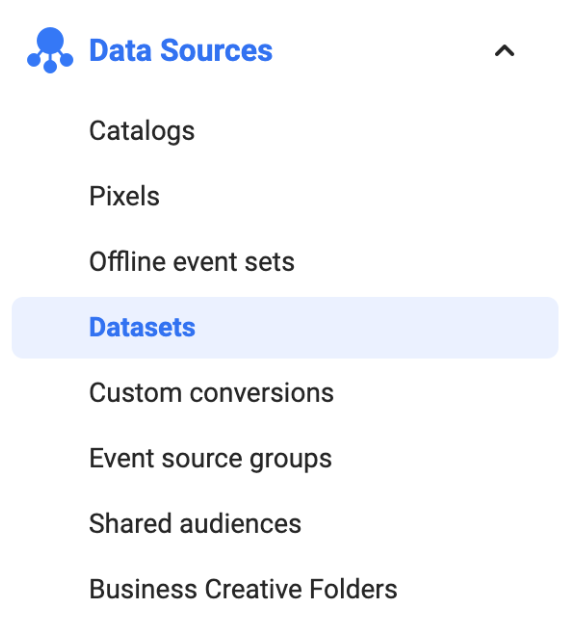If you’ve been running ads on Facebook or Instagram, you’ve probably noticed that the Meta Pixel that you’ve come to use — or Facebook Pixel, as it used to be called — has gone missing. And if you’re like a lot of people advertising on these platforms, you may have found this whole “where did my Meta Pixel go?” conundrum to be a pain.
You’re not alone. As all users, both for business and personal, have noticed over the last decade-plus, that the Facebook/Meta is constantly changing the components of their UI. It can be annoying as heck to feel like you’ve got it all down only for everything to change shortly thereafter. In that vein, you should likely expect more changes in the coming months here.
Luckily though, your pixels are in effect, and are still there. Essentially, Meta combined all the pixels together — including website, app, and offline events — into a unified view, a.k.a. the dataset. Meta’s pretty much “rebranded” the Meta Pixel — in a way… more on that in a minute — into the Meta Dataset.
The sequence here is that your pixel IDs are converted into dataset IDs. While this is a different presentation, in practice you don’t need to change anything as far as optimizing ad sets — an optimized ad set in the old system is the same as an optimized ad set under the new Meta Dataset.
What’s this Meta Dataset and how is it different from the Meta Pixel?
To understand the Meta Dataset, you have to go back to the definition of an “event” in this context. That is: An action taken by a user wherein they interact with any public-facing digital or physical platform of yours. That’s commonly thought of as your site or app (and also components thereof like chats), but it also includes more traditional spaces like your brick-and-mortar store.
For example, an event could be someone submitting a “contact us” email, checking out your store, and more. There are 17 standard events — here’s a list of all of them.
The theory behind the Meta Dataset is that contrary to the pixel(s), it allows you to connect the data of these events across multiple platforms and manage them accordingly.
Luckily for your own sanity, most likely your Meta Pixel has already been converted into a Meta Dataset automatically and in doing so preserved the events you built out when originally creating your own Meta Pixel. In this case, you don’t need to do anything here. Yay!
So, what’s the big deal and how do these dataset benefits play out?
Image Source: jonloomer.com
Mainly, while people have understandably been frustrated with this sudden change, the point behind it is that you can now connect all your assets under this one dataset umbrella. This includes integrations of apps, your site, offline activity, and messaging. (Meta actually provides this useful aid to help you decide the best dataset creation option for you, which we recommend checking out.)
You might be only measuring your website traffic currently — that’s pretty standard and something most businesses do — but you’ll still be automatically shifted to the Meta Dataset system away from the Meta Pixel, which can come in handy if you decide in the future to have a more comprehensive approach.
Diving into the benefits, datasets enable you to A) see a fuller view of your customers and also B) simplify the technological integrations to make your work possible.
Let’s start with that second point: Before this, Meta’s system required you to keep up with many different API integrations. That meant one API to connect Facebook and your site data, one API for your app, one for offline, and one for messaging, all intertwined where necessary. It also meant the maintenance and general involvement was correspondingly more complex.
With the Meta/Facebook Dataset, this is all simplified, reducing both the critical junctures within these integrations where something can go wrong and also reducing the amount of work you have to do. Bottom line: Where before you had to worry about many API integrations, now you just have to worry about one.
As for that first point, this greater integration — while simplified on your end as the admin — gives you by default a more comprehensive understanding of how users interact with your assets. With this, you can view all customer actions from all your sources under the same business need, instead of having to view these separately by source.
It again comes back to that simplification — whereas you used to need a separate ID for each integration, needing only one dataset ID for everything allows you to then view everything together under said ID.
Essentially: Once you get used to the change, it takes less work all while getting more insights from it.
Resources for creating a dataset in Meta Events Manager
Image Source: jonloomer.com
If you’re just starting out, Meta has a helpful resource on their Facebook help site to walk you through it.
Within the Meta Events Manager, there are a few possible ways to create a dataset. Here you can learn about which options are best suited towards your own needs — and from there Facebook will take you through the steps to create it.
If you’ve been frustrated with this transition, you’re definitely not alone; many have been irked by this development particularly because Facebook hasn’t done a very good job of communicating about it. We get it — it’s not a good sign for the comms side of things when a Reddit thread is one of the few good sources of information about it on the internet.
Hopefully, you can get started though with some of these resources to take the Meta Dataset from a pain in the neck to a true asset for your business.






